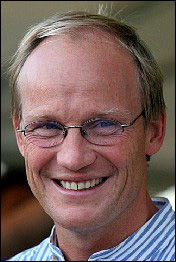Talk at Brookhaven Lab on Archimedes' Oldest Writings, May 20
April 23, 2009

Uwe Bergmann
UPTON, NY — Uwe Bergmann, a scientist at the U.S. Department of Energy’s (DOE) SLAC National Accelerator Laboratory, will give a talk titled “Archimedes’ Oldest Writings Under X-ray Vision,” at DOE’s Brookhaven National Laboratory on Wednesday, May 20, at 4 p.m. in Berkner Hall. Sponsored by Brookhaven Women in Science (BWIS) and QuarkNet, the talk is free and open to the public. Visitors to the Laboratory age 16 and older must carry a photo ID.
BWIS is a not-for-profit organization at Brookhaven Lab that promotes the advancement of women in scientific professions, and QuarkNet is an initiative funded by DOE and the National Science Foundation to involve high school teachers and their students in particle physics research about the structure of matter and the fundamental forces of nature.
Archimedes of Syracuse (287 – 212 B.C.) is considered one of the most brilliant mathematicians and thinkers of all times. The tenth-century parchment document known as the Archimedes’ Palimpsest is the oldest surviving copy of works by the Greek genius. Currently, the privately owned Palimpsest is the subject of an integrated campaign of conservation, imaging, and scholarship being undertaken at the Walters Art Museum in Baltimore. Much of the text has been imaged by various optical techniques, but significant gaps in the legibility of the writing have remained on several pages.
Large parts of these writings were recently deciphered at the Stanford Synchrotron Radiation Lightsource at SLAC. A special x-ray technique showed maps of iron in faint traces of partially erased ink. The x-ray images revealed Archimedes’ writings from some of his most important works that were hidden by twelfth-century biblical texts, mold and forged gold paintings. Join Bergmann in a fascinating journey of a 1,000-year-old parchment from its origin in the Mediterranean city of Constantinople to an x-ray beam line at SLAC in California.
Uwe Bergmann earned a Ph.D. in physics from Stony Brook University in 1994 and did his postdoctoral work at the European Synchrotron Radiation Facility in Grenoble, France, and Lawrence Berkeley National Laboratory in Berkeley, California, before he became a scientist at DOE’s Lawrence Berkeley National Laboratory in 1999. He also became an assistant researcher in the Department of Applied Science at the University of California, Davis, in 2000. He then moved on from these positions to become a staff scientist at SLAC’s Stanford Synchrotron Radiation Lightsource (SSRL) in 2003. He is currently a senior staff scientist at the facility as well as head of the Chemical & Materials Science & User Support Department at SSRL.
Call 631 344-2345 for more information. The Laboratory is located on William Floyd Parkway, one-and-a-half miles north of Exit 68 of the Long Island Expressway.
2009-10948 | INT/EXT | Newsroom









